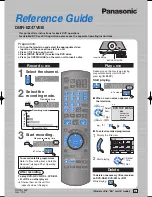
Section 11 – 3D Support
Copyright 2009-2016 Lumagen, Inc.
Radiance Pro, Rev 040116
27
Separate Left and Right
The Radiance can accept HDMI 1.4 “3D” video and output either the left-eye or right-eye image for a dual projector
3D system that uses passive 3D glasses. This 3D system configuration uses two Radiance video processors.
3D Output Settings
The Radiance has support for all of the commonly used 3D video sources. If you connect a HDMI 1.4a compliant 3D
video source and compliant 3D display, to the Radiance, you should automatically get a 3D image, using the Radiance
default settings.
The Radiance has settings that you can use to display 3D video, using non-compliant 3D video sources and displays.
The Radiance has settings to optimize the video on your 3D display. The Radiance also has settings to display 3D video
on some 2D displays (See section titled “3D Support for 2D Displays” for further details).
3D Output Setup Menu
You can select the 3D output settings based on the input number, input memory, and input video mode. For
any of the three input conditions you can select ‘All” to apply the output setup to multiple input conditions.
When making settings that apply to multiple input conditions you can leave any of the output settings
unchanged by selecting the ‘---‘ option for that output setting. Press “4” for ‘All’ and press “5” to see the
current settings. The command is:
MENU
→
Output
→
Output Setup
→
3D
→
Ok
3D Output Mode = Auto
By default the output is set to “Auto 2,1.” The selection “Auto 2,1” means the Radiance automatically reads the EDID
for the devices connected to both outputs, giving priority to Output 2, and automatically selects the appropriate output
resolution. That is, if an active device is connected to output 2, the EDID from that device is read to determine the
optimal video output resolution and the Radiance automatically selects the specified resolution. If no device is
connected to output 2, or the device connected to output 2 is turned off, the Radiance uses the EDID from the device
connected to Output 1 and sets the output resolution appropriately. Output 1 can have priority by selecting “Auto 1,2”
from the
Video Output Select Menu
.
For “Auto” modes the output vertical rate is selected based on the input vertical rate. For example, input formats
480i60, 720p60, 1080i60 automatically select a vertical output rate of 60 Hertz. Input formats 576i50, 720p50, and
1080i50 automatically select a vertical output rate of 50 Hz. For a 1080p24 input format a 24 Hz output vertical rate is
selected if the display supports a 24 Hz output vertical rate, otherwise a 60 Hz rate is selected.
If the priority output is connected to a 3D device, and the secondary output’s device is not 3D, when a 3D source is
detected the Radiance automatically disables video to the 2D output.
For analog displays and digital displays, that do not properly support EDID, the output mode must be selected.
3D Output Mode = Specific Format
The Radiance will convert all 3D input formats to the specified 3D output format. For example all 3D input modes can
be converted to a 1080p60 side-by-side output mode.
3D Output Type = Auto
The Radiance has support for all of the commonly used 3D Types (Frame Packed, Side-by-Side, Top-Bottom, and
Frame Sequential). When the output ‘Type’ is set to ‘Auto’ the Radiance will convert all 3D modes and types to HDMI
1.4a mandatory 3D format.
3D Output Type = Specific 3D Type
The Radiance will convert all 3D input types to the specified 3D output type. i.e. All 3D input types can be converted
to 3D Frame Sequential to drive a CRT display/projector.
3D EDID Configuration
By default the display’s 3D capability is automatically detected using its EDID information. However, some 3D
displays do not properly report their 3D capability in their EDID. This command allows the 3D output capability to be
manually enabled (or disabled). The command is







































